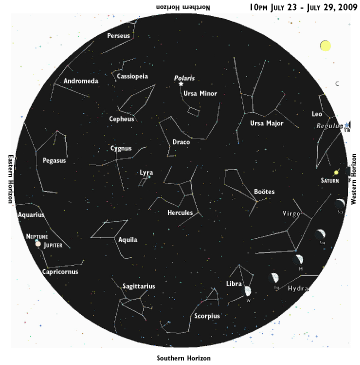
Volume XVII, Issue 30 # July 23 - July 29, 2009 |
 |
 |
Sky Watch
by J. Alex Knoll
Twilight’s Golden Star
With its rings subdued, Saturn blends in with the background
Thursday’s young crescent moon appears low in the west after sunset, around 8:25 this week. Lower toward the horizon twinkles blue-white Regulus, setting little more than an hour after dark and succumbing to the sun’s glow over the coming weeks.
That same night you’ll find Saturn some 20 degrees east of the moon, but by Friday the moon has halved the gap, with the ringed planet less than 10 degrees from the crescent’s upper point. Saturday night the moon trails Saturn by more than 10 degrees, and while the moon waxes night by night, appearing more than a dozen degrees to the east, Saturn slowly sinks closer and closer to the day-lit horizon.
Like Jupiter, Saturn is a gaseous giant made primarily of hydrogen and helium, the same elements that fuel fission within stars. Saturn is enveloped in much the same reflective cloud covering as Jupiter and is nearly as large. However, Saturn is almost twice as far from the sun as its neighbor, so that seen from earth the ringed planet is far less brilliant, appearing like a bright golden star.
Saturn’s most prominent feature, its rings, unfortunately face us edge-on, as a result appearing their smallest in more than 12 years, and it will take that long again before the rings open up to maximum effect.
While the not-so-ringed planet sets in the west, Jupiter climbs the east horizon, outshining any star and appearing all the brighter amid the dim stars of the water constellations Capricornus and Aquarius. Not until the wee hours before dawn, when Jupiter is high in the south, is he joined by another visible planet. First Mars crests the northeast horizon around 3am. 45 minutes later Venus blazes into view.
Illustration: © Copyright 1925 M.C. Escher/Cordon Art-Baarn-Holland; Graphics: © Copyright 2009 Pacific Publishers. Reprinted by permission from the Tidelog graphic almanac. Bound copies of the annual Tidelog for Chesapeake Bay are $14.95 ppd. from Pacific Publishers, Box 480, Bolinas, CA 94924. Phone 415-868-2909. Weather affects tides. This information is believed to be reliable but no guarantee of accuracy is made by Bay Weekly or Pacific Publishers. The actual layout of Tidelog differs from that used in Bay Weekly. Tidelog graphics are repositioned to reflect Bay Weekly’s distribution cycle.Tides are based on National Oceanic and Atmospheric Administration and are positioned to coincide with high and low tides of Tidelog.
